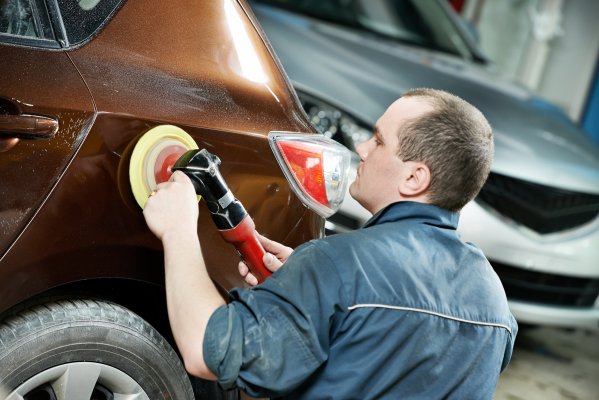Polishing your car by yourself has a lot of benefits. First, it lets you personally determine how much shine you put in the car. You can also lessen costs from having to visit a car shop. Lastly, you can have more experience in polishing the car and improving your maintenance skills.
If you want to get the best shine for the surface of your car, familiarizing yourself with buffing pads can greatly help. This can reduce time for shining, make it easier to remove scratches, and give you a better overall result.
When polishing anything, you would need something to gently apply force to something that has a rough surface. Polishing is done with many products such as waxes and sealants which you may already be familiar with. The equivalent of this for cars are buffing pads.
Buffing pads can be made from various materials depending on how rough you need it to be. There are those made from fiber, those from wool, and more. The most popular material is foam because it is highly absorbent yet rough enough for polishing.
Buffing pads usually come in circular forms which you can attach to your polishing tool. There are those specifically for rotary polishers and those for dual-action polishers. The latter is more recommended for beginner users.
Microfiber pads
Microfibers are the cross between the foam and wool pad. It comes with just enough smoothness and aggressiveness depending on the specific variation you will use. The exact microfiber used for creating it generally depends on the manufacturer. These are mostly used for dual-action polishers.
· Cutting microfiber pads – This is the rougher pad used for removing scratches in the surface.
· Finishing microfiber pads – These are used for improving shine and finishing the polishing process.
Wool pads
Wool pads are the most aggressive and are good for removing scratches and swirls on the car’s surface. These are usually used for rotary polishers. These are quite coarse but generate low heat. The downside is that the hairs of the pad may leave behind some scratches. It also lacks variations.
Foam pads
They are generally the gentlest pad that is most preferred for improving the shine of the car’s surface. However, it also has several variations depending on aggressiveness.
· Compounding foam pads – these have the roughest surface and are generally advised for removing any defects in the surface.
· Polishing foam pads – this is a mid-aggressive pad
· Finishing foam pads – these are for putting a shining wax. These are the least rough and can be used for finishing polishing.
When polishing the car, it is better to start with the compounding pads followed by the polishing and finishing pads.
How do buffing pads polish the car?
To use a polishing tool, you simply need to press the buffing pad towards the car’s surface and then turn the machine on. It will start rapidly rotating which can help smooth over any imperfection in the car’s surface. This tool creates thousands of rotations per minute.
Buffing pads work by being an abrasive surface on the car. With its rapid movement along with the buffing compound, it can smooth out scratches and remove paint swirls. It will also absorb any excess oil on the surface. Pads can be pressed throughout the whole surface of the car including its edges as it is flexible.
Buffing pads are best used with a polisher to make the process faster and for you to have better results. They are more recommended compared to using a towel because of its abrasive surface.
How are buffing pads used?
Buffing pads can be used both with a polishing tool or through hand polishing.
For the former, you would need to attach it to the backing plate using Velcro or with glue. Next, you will pour the polishing compound on the pad. Be sure that it always has this while pressed on the surface of the car to ensure that it will be smooth enough. You can then start turning on the machine to begin polishing the different parts of the surface of the car.
When hand polishing, the only difference is that you would need to apply more force on the pad by dragging it back and forth on the surface of the car.
These need to be cleaned every now and then to be sure it will still be effective. Foam pads can be cleaned by pressing a towel to it which then absorbs the contaminants on it. Microfiber pads can be cleaned by washing. Lastly, wool pads are cleaned using a spur tool which are held against the pad.
Aside from this, you can also simply soak the pads. You can add dish soap to this to ensure that oil and other contaminants will be removed. It is important to do this quickly so that the contaminants will not dry instantly. It is good to have a bucket where you can soak the pads while they are not being used when working.
When cleaning the pad, be sure to be gentle on it. After all, it has two layers, one for attaching it to the backing plate of the car and another for actually polishing the car. The two parts may be separated accidentally in case you apply too much pressure.
Using a dual-action polisher for your car
As mentioned above, microfiber and foam pads are the most recommended for dual-action polishers. There are some that offer wool pads for it but these are rare.
A dual-action polisher is most recommended for all users who want to easily clean their cars without the danger of accidentally causing burns or further scratches to the surface. This is because these tools use a variety of directions when polishing the car compared to rotary polishers that only go one direction. Because of this, it builds up heat less as it generates less friction. It also results in a better shine for the car.
To get the best results, you can try using multiple pads. First, you can use a cutting microfiber pad to reduce any large scratches on the car’s surface and any swirls in the paint. After this, you can use a finishing foam pad for improving its shine.
Buffing pads are attached to the polisher using the backing plate. This material comes with an attachment tool usually made from Velcro. Some also come with a glue pad to make it stick. This sturdily holds the pads as it polishes the car’s surface. It is better for this to be made from rubber as to decrease the vibrations whenever polishing the car.
How should you choose a buffing pad for your car?
One of the major factors is the material used for it. Foam pads are easier to manage and are absorbent. Wool pads are more absorbent but can be aggressive on the surface of the car. The differences between these will be discussed later in the article.
Next, you should look for a product that sticks properly to your polishing tool. This ensures that it won’t accidentally slip out while you are using it. It also lessens the vibrations which lessens the strain on your hands.
The exact construction of the product greatly affects its performance regardless of the material. Because of this, you must look for a pad that has great airflow. You must also look for one that can easily absorb the polishing compound. The best pads have a manufacturer’s warranty to ensure the best quality.
Lastly, the type of polishing tool that you are using should also be a factor. Generally, wool pads are more advised for rotary wheels as they generate less heat but can remove scratches easily. Microfiber pads and foam pads are more recommended for dual-action polishing pads.
Those who will manually polish the car with their hands are advised to purchase the toughest foam pads as they can easily control the pressure they apply and be able to avoid accidentally scratching the surface of the car. A pad with a more aggressive surface can speed up the whole process of hand polishing.
Choosing the material for your buffing pad
The buffing pads are all compatible with both the rotary and the dual-action polisher. Choosing the best one mainly depends on your car’s needs and how you use the product. When choosing one, you must first know that these have several categories under them that are different in terms of the roughness of its surface. You can also use a mix of this for the best results.
There are three most popular polishing pads including wool, foam, and microfiber. Microfiber and foam is most recommended for dual-action polishers while wool pads are for rotary wheels. If you want to find out more about the best pieces of equipment to use to get your car back to brand new shininess, take a look at our reviews of the best dual actions polishers on the market today.





